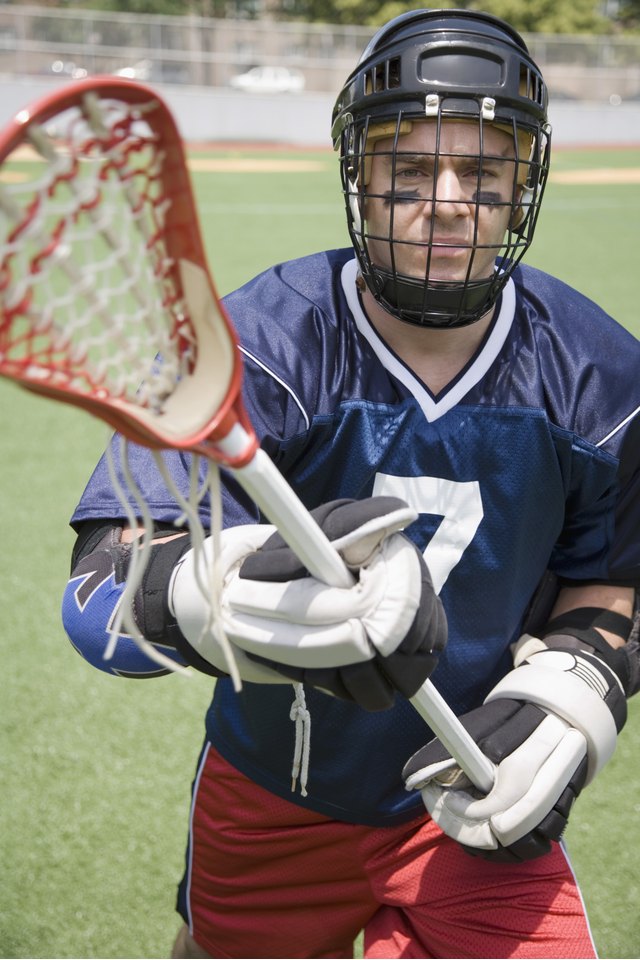Lacrosse Rules & Regulations: Stick Requirements

The lacrosse stick, also known as the “crosse,” is used to catch, pass and shoot the ball. It’s also used to check the opponent’s stick and try to dislodge the ball. In the men’s game, players can also check an opponent’s body with the crosse, within certain limitations. If an official discovers an illegal stick before the game, the player won’t be permitted to use the stick during the contest. If an illegal stick is detected during the game, however, the player and team typically receives a penalty, so it’s important that each lacrosse stick conforms to the appropriate rules.
Overall Appearance
Lacrosse sticks at all levels contain long, thin handles with a roughly triangular-shaped pocket at the far end for handling the ball. Players may apply tape or a similar material to the handle to improve its grip, but may not otherwise alter a stick, such as shaving it down to lighten the stick or to make it more flexible. Sticks are made from a variety of materials, including wood, fiberglass or synthetic substances. Hollow metal sticks must include a protective end cap.
Length
The length of a lacrosse stick varies according to age, gender and the player’s position. In high school and college men’s lacrosse, the smaller field stick, known as the “short crosse,” is 40 to 42 inches long. Additionally, four field players may use a “long crosse” measuring 52 to 72 inches. In the 11-and-younger age group, the long crosse is limited to 52 inches. There is no long crosse for 9-and-younger field players, all of whom use a stick measuring between 37 and 42 inches. Female players also don’t use a long crosse. All women’s field sticks measure from 35 ½ to 43 ¼ inches. Male goalkeepers may use a stick ranging between 40 and 72 inches long. Women’s goalie sticks are 35 ½ to 48 inches long, according to NCAA rules, but girls may use goalie sticks up to 52 inches long. Only the goalkeeper may use a goalie stick, and each team is limited to one goalie at a time.
Pocket -- Men’s Sticks
The pocket is located within a stick’s head area. It will always be narrower near the shaft than it is at the far end. Men’s sticks typically contain a mesh pocket. The head of a male field player’s stick must be 6 to 10 inches wide at its widest point and at least 10 inches long. The head of a goalie stick must measure 10 to 12 inches wide at its widest point and a maximum of 16 ½ inches long. The pocket can’t be strung too deeply, otherwise defenders wouldn’t be able to dislodge the ball. For example, if a stick is held horizontally, the top of a ball placed in the pocket can’t dip below the head’s side wall.
Pocket -- Women’s Sticks
Women field players may not use sticks with mesh pockets. Instead, their pockets are made primarily with four or five leather or synthetic thongs. The pocket also includes eight to 12 stitches of cross-lacing and up to two strings, referred to as shooting/throw strings. A goalie stick may contain six or seven thongs, or it may include a mesh pocket. The field stick’s head measures 25.4 to 30.5 centimeters long, or about 10 to 12 inches, and 18 to 23 centimeters wide, about 7 to 9 inches. A goalie stick’s head can be up to 42 centimeters long, or 16 ½ inches, and 33 centimeters wide, or 13 inches, at its widest point. The top of a ball placed in the pocket of a women’s field stick must extend above the head’s upper edge when the stick is held horizontally.
References
Writer Bio
This article was written by the CareerTrend team, copy edited and fact checked through a multi-point auditing system, in efforts to ensure our readers only receive the best information. To submit your questions or ideas, or to simply learn more about CareerTrend, contact us [here](http://careertrend.com/about-us).
